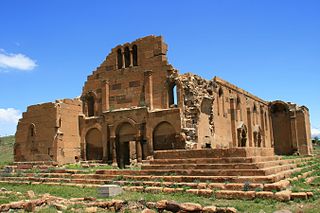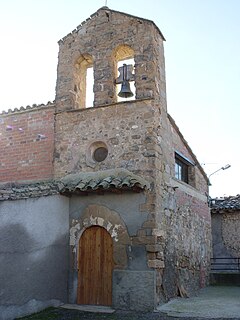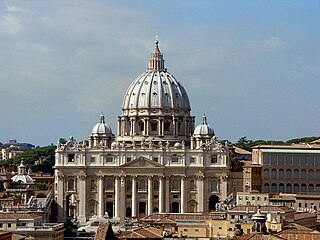
The Basilica of Saint Denis is a large medieval abbey church in the city of Saint-Denis, now a northern suburb of Paris. The building is of singular importance historically and architecturally as its choir, completed in 1144, shows the first use of all of the elements of Gothic architecture.

The Papal Basilica of St. Peter in the Vatican, or simply St. Peter's Basilica, is an Italian Renaissance church in Vatican City, the papal enclave within the city of Rome.

The architecture of cathedrals, basilicas and abbey churches is characterised by the buildings' large scale and follows one of several branching traditions of form, function and style that all ultimately derive from the Early Christian architectural traditions established in the Constantinian period.

The basilica and the monastery of San Francisco de Asis were built in Havana, Cuba at the end of the sixteenth century (1580–91) as the home of the Franciscan community in Havana. The basilica was altered in 1730.
This is a timeline of architecture, indexing the individual year in architecture pages. Notable events in architecture and related disciplines including structural engineering, landscape architecture, and city planning. One significant architectural achievement is listed for each year.

The Cathedral-Basilica of Our Lady of the Pillar is a Roman Catholic church in the city of Zaragoza, Aragon (Spain). The Basilica venerates Blessed Virgin Mary, under her title Our Lady of the Pillar praised as "Mother of the Hispanic Peoples" by Pope John Paul II. It is reputed to be the first church dedicated to Mary in history.

The Metropolitan Cathedral Basilica of the Holy Saviour or Cathedral of San Salvador is a Roman Catholic church and minor basilica in the centre of Oviedo, in the Asturias region of northern Spain.

The Basilica of Saint-Sernin is a church in Toulouse, France, the former abbey church of the Abbey of Saint-Sernin or St Saturnin. Apart from the church, none of the abbey buildings remain. The current church is located on the site of a previous basilica of the 4th century which contained the body of Saint Saturnin or Sernin, the first bishop of Toulouse in c. 250. Constructed in the Romanesque style between about 1080 and 1120, with construction continuing thereafter, Saint-Sernin is the largest remaining Romanesque building in Europe, if not the world. The church is particularly noted for the quality and quantity of its Romanesque sculpture. In 1998 the basilica was added to the UNESCO World Heritage Sites under the description: World Heritage Sites of the Routes of Santiago de Compostela in France.

The Basilica of Notre-Dame de Fourvière is a minor basilica in Lyon. It was built with private funds between 1872 and 1884 in a dominant position overlooking the city. The site it occupies was once the Roman forum of Trajan, the forum vetus, thus its name.

The Basilica of Begoña is a basilica in Bilbao, in Spain, dedicated to the patron saint of Biscay, the Virgin Begoña.

A crossing, in ecclesiastical architecture, is the junction of the four arms of a cruciform (cross-shaped) church.

National Shrine of the Little Flower Basilica Catholic Church in Royal Oak, Michigan is a well known Roman Catholic church and National Shrine executed in the lavish zig-zag Art Deco style. The structure was completed in two stages between 1931 and 1936. The sanctuary stands at 2100 West Twelve Mile Road at the northeast corner of Woodward Avenue and is a parish of the Roman Catholic Archdiocese of Detroit. Construction was funded by the proceeds of the radio ministry of the controversial Father Charles Coughlin who broadcast from the tower during the 1930s.

Yererouk, also Yereruyk or Ererouk, is an archeological site characterized by the presence of an ancient Armenian church near the village of Anipemza in the Shirak Province of Armenia. Yererouk was built on a plateau near the Akhurian River which defines the frontier with Turkey, about 5 km southeast of the ancient city of Ani.

The bell gable is an architectural element crowning at the upper end of the wall of church buildings, usually in lieu of a church tower. It consists of a gable end in stone, with small hollow semi-circular arches where the church bells are placed. It is a characteristic example of the simplicity of Romanesque architecture.

The Cathedral Basilica of St. Louis Gonzaga is the main church in the city of Novo Hamburgo, Rio Grande do Sul.
The Rainbow Coffee House was a famous coffee house located at 15 Fleet Street, London. It was opened by James Farr in 1657, becoming London's second coffee house.

The Embassy of Colombia in London is the diplomatic mission of the Republic of Colombia in the United Kingdom. It is headed by the Ambassador of Colombia to the United Kingdom. It is located in the Knightsbridge district in a building it shares with the Embassy of Ecuador, near Harrods, Hyde Park, and Hans Place, precisely at 3 Hans Crescent at the intersection of Basil Street, and it is serviced by the Knightsbridge station.

The Basilica of the Immaculate Conception and Assumption of Our Lady is a basilica in Barcelona, Catalonia. The church originated as the Jonqueres Monastery, that was moved stone by stone when the land of the monastery was to be demolished. In 1879, a bell tower was added from the church of San Miguel which was also going to be demolished. The rectory stands on the left side of the bell tower and is a historicist building built at the end of the 19th century. On 20 February 2009, Pope Benedict XVI granted the title of minor basilica to the church, which became the eighth basilica in the city.

The Iglesia de Santa Leocadia is a church located in Toledo, in Castile-La Mancha, Spain. The Toledan tradition maintains that this church is built on the site of the house where Saint Leocadia of Toledo was born, to which would belong a small underground room, where it is affirmed that it made prayer. This cave corresponds to the crypt located next to the right pillar of the presbytery, and is covered with a plaster crossery vault, which can be dated in the first half of the 16th century. In the tower and in the facade of the church are preserved, embedded, some fragments of Visigothic style's reliefs.

























